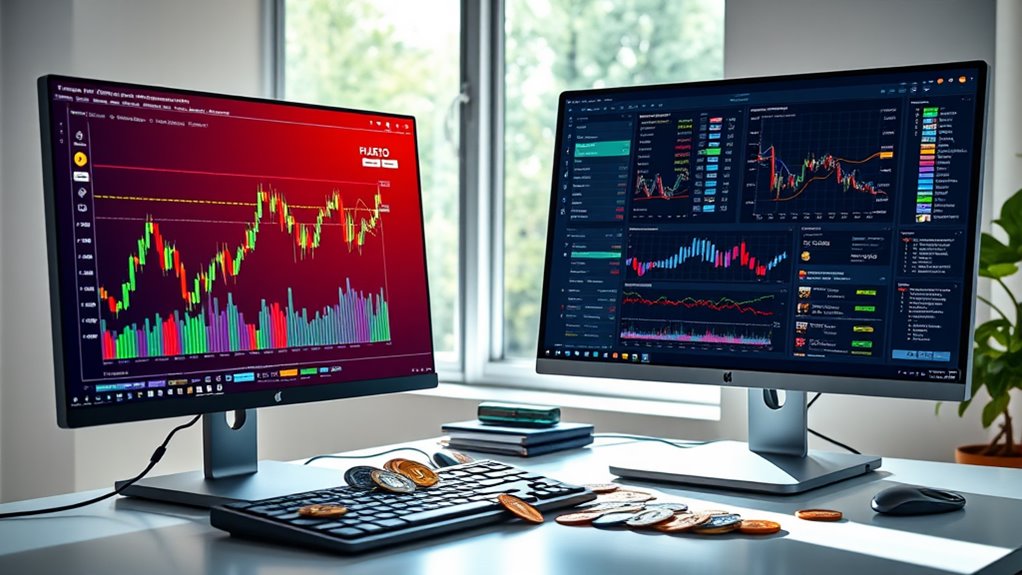
What Is a Crypto Exchange: a Beginner’s Guide to Trading Cryptocurrency
Cryptocurrency exchanges are online platforms where users can buy, sell, and trade digital currencies. These marketplaces connect buyers with sellers, providing tools for price analysis and secure storage options. Exchanges require registration and typically some form of identity verification before allowing deposits. They come in two main varieties: centralized exchanges managed by companies and decentralized exchanges offering greater user control. Understanding exchange fees, security features, and trading strategies forms the foundation for successful cryptocurrency trading.
Key Takeaways
- Crypto exchanges are online platforms that connect buyers and sellers for trading digital currencies.
- Exchanges come in two types: centralized (run by companies) and decentralized (peer-to-peer without intermediaries).
- Getting started requires registration, identity verification (KYC), and funding your account through supported payment methods.
- Trading involves understanding order types (market, limit, stop) and fee structures that impact overall returns.
- Security best practices include using multi-factor authentication, strong passwords, and considering cold storage for long-term holdings.
Understanding Cryptocurrency Exchanges: The Basics

While traditional financial markets have served investors for centuries, cryptocurrency exchanges represent a modern innovation that has transformed how digital assets are traded. These online platforms facilitate the buying and selling of cryptocurrencies by connecting buyers with sellers in peer-to-peer transactions.
Crypto exchanges provide essential functions including price discovery through trading activity and storage options for digital assets. Users must register accounts and complete Know Your Customer (KYC) verification before depositing funds in either fiat or digital currencies.
Once authenticated, traders can access the marketplace where hundreds of different digital assets are available. These platforms serve as bridges between traditional financial systems and the cryptocurrency ecosystem, enabling both fiat-to-crypto and crypto-to-crypto transactions while providing tools for price analysis and market monitoring. Additionally, many exchanges like Bybit and Coinbase offer educational resources to help beginners navigate the complexities of trading.
Centralized vs. Decentralized Exchanges: Key Differences

When traders enter the cryptocurrency space, they typically face a fundamental choice between two distinct exchange models. Centralized exchanges (CEXs) operate under a single entity with robust security measures and regulatory compliance, making them user-friendly for beginners. In contrast, decentralized exchanges (DEXs) function without central authority, giving users complete control over their funds and greater trading privacy.
| Feature | Centralized Exchanges | Decentralized Exchanges |
|---|---|---|
| Control | Company holds funds | User retains private keys |
| Liquidity | Higher trading volume | Generally lower liquidity |
| Regulation | KYC/AML requirements | Minimal identity verification |
Each model presents different trade-offs regarding security, accessibility, and autonomy. CEXs offer better liquidity and speed but are vulnerable to large-scale hacks, while DEXs provide enhanced privacy but may have smart contract vulnerabilities. Additionally, CEXs are known for their higher liquidity in comparison to DEXs, which can impact trading efficiency.
How to Open an Account and Start Trading

Getting started with cryptocurrency trading requires a systematic approach to account setup and platform familiarization. The process begins by selecting an exchange and registering through their website, providing an email address and creating a strong password.
Most platforms require KYC verification, where users must submit identification documents to comply with financial regulations. During this step, users often need to provide identification documents like passports or driver’s licenses to complete the verification process.
After verification, users can deposit funds through various payment methods including bank transfers, credit cards, or existing cryptocurrency.
Before making trades, it’s important to understand the different order types available, such as market, limit, and stop orders.
Implementing risk management strategies like setting stop-loss orders and proper position sizing helps protect investments against market volatility.
For additional security, enabling two-factor authentication and considering external wallet storage for long-term holdings is recommended.
Trading Fees and Costs Explained

When trading cryptocurrency, understanding the fee structure of exchanges is essential for maximizing profits and minimizing costs.
Exchanges typically charge various fees, including maker fees, taker fees, deposit fees, withdrawal fees, and sometimes inactivity fees, which can greatly impact overall returns.
Savvy traders can reduce their trading costs by selecting exchanges with competitive fee structures, holding native exchange tokens for discounts, increasing their trading volume to qualify for lower tiered rates, and timing their transactions strategically. Additionally, understanding trading fees is crucial as they can erode investment returns over time.
Trading Fees Comparison
Understanding the complex structure of trading fees can greatly impact a cryptocurrency trader’s profitability over time. Different exchanges offer varying fee structures that can notably affect trading outcomes, especially for frequent traders.
| Exchange | Maker Fees | Taker Fees | Special Discounts |
|---|---|---|---|
| Binance | 0.1-0.0124% | 0.1-0.0124% | BNB token reduction |
| Coinbase | 0.4-0.6% | 0.4-0.6% | Volume-based tiers |
| KuCoin | Starting 0.1% | Starting 0.1% | KCS token discounts |
| MEXC | As low as 0% | As low as 0.02% | Volume-based tiers |
Most exchanges reduce fees based on 30-day trading volume, while others offer discounts for using native tokens. Traders can minimize costs by using limit orders instead of market orders and by qualifying for VIP programs through higher trading volumes. Additionally, understanding security measures is crucial to ensure that your trading activities remain safe while you navigate fee structures.
Hidden Costs Revealed
Beyond the advertised trading fees, cryptocurrency traders face numerous hidden costs that can greatly erode profits over time. These include gas fees during network congestion, which can spike dramatically during high-demand periods, and bid-ask spreads, which widen in volatile or low-liquidity markets.
Conversion costs when moving between fiat currencies and cryptocurrencies often hide in exchange rates, with significant variations across platforms. Traders can minimize these expenses by conducting transactions during low-traffic hours and using Layer 2 solutions like Polygon or Optimism, which process transactions off the main blockchain.
The regulatory landscape also impacts costs, as exchanges may pass compliance expenses to users. Additionally, slippage can further affect the actual price at which trades are executed, adding to the overall trading costs and profitability. Understanding these hidden costs allows traders to develop more accurate profit projections and implement effective cost-management strategies.
Fee Reduction Strategies
Savvy cryptocurrency traders employ multiple strategies to minimize trading fees, which can greatly impact overall profitability. By using limit orders instead of market orders, traders can qualify for lower maker fees rather than higher taker fees. Additionally, consolidating smaller trades into larger transactions often reduces the total fee burden through tiered fee structures. Many exchanges offer discounts that can considerably lower costs:
- Using the exchange’s native token for fee payments (often providing 25-50% discounts)
- Increasing trading volume to reach lower fee tiers (potentially saving 0.1-0.2% per trade)
- Timing transactions during periods of lower network congestion (particularly important for blockchain transfers)
Regularly comparing fee structures across exchanges remains essential, as even small percentage differences compound notably over time. Understanding the benefits of limit orders can further enhance a trader’s ability to manage costs effectively.
Essential Security Measures to Protect Your Investments

While investing in cryptocurrency offers significant opportunities, securing those investments requires multiple layers of protection against increasingly sophisticated threats.
Investors should implement multi-factor authentication (MFA) and use strong, unique passwords for all accounts.
Encryption technology, both for data in transit and at rest, provides essential protection for sensitive information.
Cold storage wallets offer superior security by keeping crypto assets offline and away from potential hackers.
Regular security audits and compliance with KYC regulations help identify vulnerabilities before they can be exploited.
Implementing withdrawal whitelists and transaction verification processes prevents unauthorized transfers.
Additionally, having a thorough incident response plan, including secure backups and recovery procedures, guarantees rapid action if security is compromised. Furthermore, utilizing insurance policies from reputable exchanges can provide an additional layer of security for your assets.
Popular Crypto Exchanges for Beginners

With robust security measures in place, new cryptocurrency investors need a trustworthy platform to start their trading journey. Several exchanges cater specifically to beginners, offering user-friendly interfaces and educational resources.
Finding a secure, user-friendly platform is essential for newcomers embarking on their cryptocurrency investment journey.
Binance, Coinbase, and Kraken have established themselves as leaders in the space, each providing unique features for newcomers.
- Simplified purchasing options like Bybit’s one-click buy feature eliminate confusion when making your first crypto purchase.
- Educational resources from Binance Academy and Coinbase help demystify cryptocurrency concepts through thorough guides.
- Mobile-focused platforms such as Crypto.com enable trading on-the-go, fitting seamlessly into your digital lifestyle.
Most beginner-friendly exchanges support multiple payment methods, including credit cards and bank transfers, while offering access to a variety of cryptocurrencies to explore as confidence grows. Furthermore, these exchanges prioritize security features like two-factor authentication and encryption to protect user assets.
Common Trading Strategies for Newcomers

New cryptocurrency investors frequently encounter a variety of trading strategies that can greatly impact their success in the volatile crypto markets.
Beginners often start with passive approaches like Dollar-Cost Averaging (DCA), which involves investing fixed amounts regularly to minimize the impact of volatility. HODLing, another popular strategy, focuses on long-term holding regardless of short-term price movements.
Those with more time for market monitoring might explore active strategies like day trading or swing trading, which require technical analysis skills and constant attention.
Newcomers should select strategies based on their risk tolerance, available time, and investment goals. Starting with simpler approaches allows investors to gain experience while implementing essential risk management tools like stop-loss orders. Additionally, understanding various trading strategies is crucial for adapting to the dynamic nature of the cryptocurrency market.
As traders become more comfortable, their strategies can evolve alongside changing market conditions.
Frequently Asked Questions
How Long Do Crypto Withdrawals Typically Take to Process?
Cryptocurrency withdrawals typically process within a few hours to 24 hours, depending on network congestion, transaction fees, exchange policies, and blockchain confirmation requirements. External factors can occasionally extend processing times further.
Can I Trade Cryptocurrencies Without Providing ID Verification?
Some exchanges like KuCoin and TradeOgre permit cryptocurrency trading without ID verification, often with withdrawal limits. Decentralized platforms such as Bisq and Uniswap also offer KYC-free trading, though with potential regulatory and security risks.
What Happens to My Assets if an Exchange Shuts Down?
When an exchange shuts down, assets may be lost as users become unsecured creditors in bankruptcy proceedings. Without deposit insurance, customers often recover only fractions of their holdings after legal fees deplete available funds.
Are Crypto Exchange Earnings Taxable in Most Countries?
Crypto exchange earnings are generally taxable in most countries. Governments typically apply capital gains or income tax depending on whether activities are considered trading, mining, or staking. Tax rates and regulations vary considerably by jurisdiction.
How Do Exchanges Handle Hard Forks and Airdrops?
Exchanges typically assess hard forks and airdrops for technical viability, security, and customer demand. They may suspend trading temporarily, implement replay protection, and decide whether to distribute new assets to eligible users based on holdings.
Conclusion
Steering through the cryptocurrency world requires patience and education. By understanding exchange types, account setup processes, fee structures, and security practices, beginners can make informed decisions. While the crypto market may seem overwhelming at first, taking small steps and learning the ropes will eventually help new traders find their footing. With proper research and cautious trading strategies, even newcomers can thrive in this digital financial landscape.












